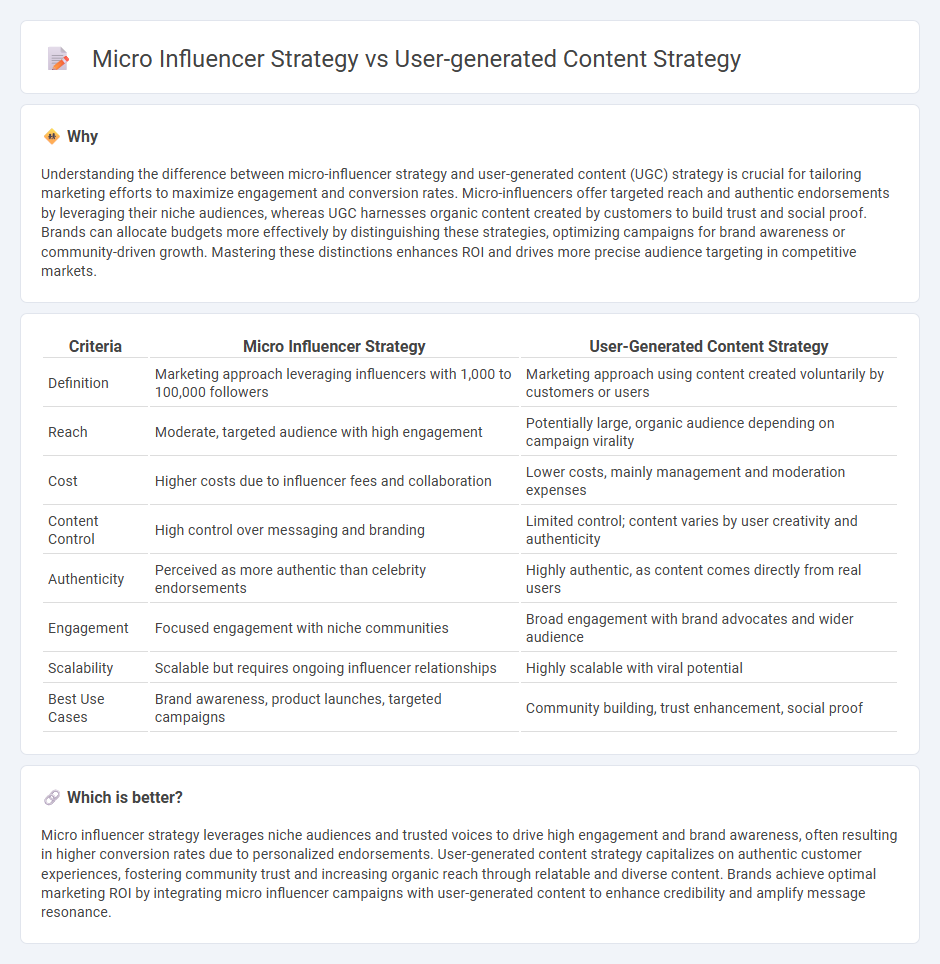
Micro influencer strategies leverage niche personalities with engaged audiences to drive authentic brand endorsements, while user-generated content strategies capitalize on organic customer creations to enhance social proof and trust. Both methods boost brand visibility and credibility through genuine interactions, yet micro influencer marketing focuses on curated influence, whereas user-generated content emphasizes community-driven advocacy. Explore how these approaches can uniquely elevate your marketing efforts.
Why it is important
Understanding the difference between micro-influencer strategy and user-generated content (UGC) strategy is crucial for tailoring marketing efforts to maximize engagement and conversion rates. Micro-influencers offer targeted reach and authentic endorsements by leveraging their niche audiences, whereas UGC harnesses organic content created by customers to build trust and social proof. Brands can allocate budgets more effectively by distinguishing these strategies, optimizing campaigns for brand awareness or community-driven growth. Mastering these distinctions enhances ROI and drives more precise audience targeting in competitive markets.
Comparison Table
| Criteria | Micro Influencer Strategy | User-Generated Content Strategy |
|---|---|---|
| Definition | Marketing approach leveraging influencers with 1,000 to 100,000 followers | Marketing approach using content created voluntarily by customers or users |
| Reach | Moderate, targeted audience with high engagement | Potentially large, organic audience depending on campaign virality |
| Cost | Higher costs due to influencer fees and collaboration | Lower costs, mainly management and moderation expenses |
| Content Control | High control over messaging and branding | Limited control; content varies by user creativity and authenticity |
| Authenticity | Perceived as more authentic than celebrity endorsements | Highly authentic, as content comes directly from real users |
| Engagement | Focused engagement with niche communities | Broad engagement with brand advocates and wider audience |
| Scalability | Scalable but requires ongoing influencer relationships | Highly scalable with viral potential |
| Best Use Cases | Brand awareness, product launches, targeted campaigns | Community building, trust enhancement, social proof |
Which is better?
Micro influencer strategy leverages niche audiences and trusted voices to drive high engagement and brand awareness, often resulting in higher conversion rates due to personalized endorsements. User-generated content strategy capitalizes on authentic customer experiences, fostering community trust and increasing organic reach through relatable and diverse content. Brands achieve optimal marketing ROI by integrating micro influencer campaigns with user-generated content to enhance credibility and amplify message resonance.
Connection
Micro-influencer strategy leverages individuals with highly engaged niche audiences to create authentic content that resonates deeply with target demographics. User-generated content strategy encourages customers to share their genuine experiences and endorsements, which enhances trust and brand credibility. Both strategies synergize by amplifying authentic voices, driving higher engagement, and fostering stronger community connections within marketing campaigns.
Key Terms
Authenticity
User-generated content strategy leverages authentic consumer experiences and testimonials, fostering genuine engagement and trust among audiences. Micro influencer strategy emphasizes collaborations with niche influencers whose genuine endorsements resonate deeply with their specific followers, enhancing credibility. Explore how harnessing both strategies can maximize authenticity and drive meaningful brand connections.
Reach
User-generated content (UGC) strategy leverages authentic content from everyday customers, driving organic reach through genuine engagement and social proof across social platforms. Micro-influencer strategy targets niche audiences by partnering with individuals who have 1,000 to 100,000 followers, enabling brands to tap into highly engaged communities for precise reach. Explore detailed insights to determine which approach maximizes your brand's reach effectively.
Engagement
User-generated content strategy leverages authentic posts from customers to boost engagement by fostering trust and community interaction. Micro influencer strategy targets niche audiences with influencers who have high engagement rates, creating personalized and compelling content that resonates deeply. Explore how each strategy can amplify your brand's engagement to determine the best fit for your marketing goals.
Source and External Links
User-Generated Content Strategy: Step-by-Step - Flowbox - Creating a user-generated content strategy involves setting clear objectives, such as increasing brand awareness or engagement, and leveraging authentic customer contributions to drive measurable campaign success.
UGC Content 101: A Comprehensive Introduction - Key elements of a strong UGC strategy include clear communication about desired content, aligning UGC with brand goals, regular content moderation, and using analytics to optimize performance.
User-Generated Content (UGC) Examples + How To Use It - Effective UGC strategies encourage audience participation through contests, branded hashtags, and community engagement while monitoring results to understand which content resonates best with the audience.
 dowidth.com
dowidth.com